Professional Skills Portfolio Presentation Project (PRSK4048)
VerifiedAdded on 2020/11/23
|26
|4789
|163
Project
AI Summary
This Professional Skills Portfolio assignment (PRSK4048) encompasses several key areas of professional development, including teamwork, professional ethics, and project management. The assignment requires students to complete a Belbin questionnaire to identify team roles, develop a team Code of Conduct, and participate in an in-class ethics writing exercise. Furthermore, students are tasked with creating a Gantt chart for project management and engaging in written discussions on these topics. The portfolio is divided into four main tasks, each focusing on different aspects of professional skills in action, with individual and group components. The tasks include a Belbin questionnaire for teamwork, a Code of Conduct and in-class writing for professional ethics, and a Gantt chart and presentation evidence for project management, culminating in a comprehensive evaluation of the student's professional skills.
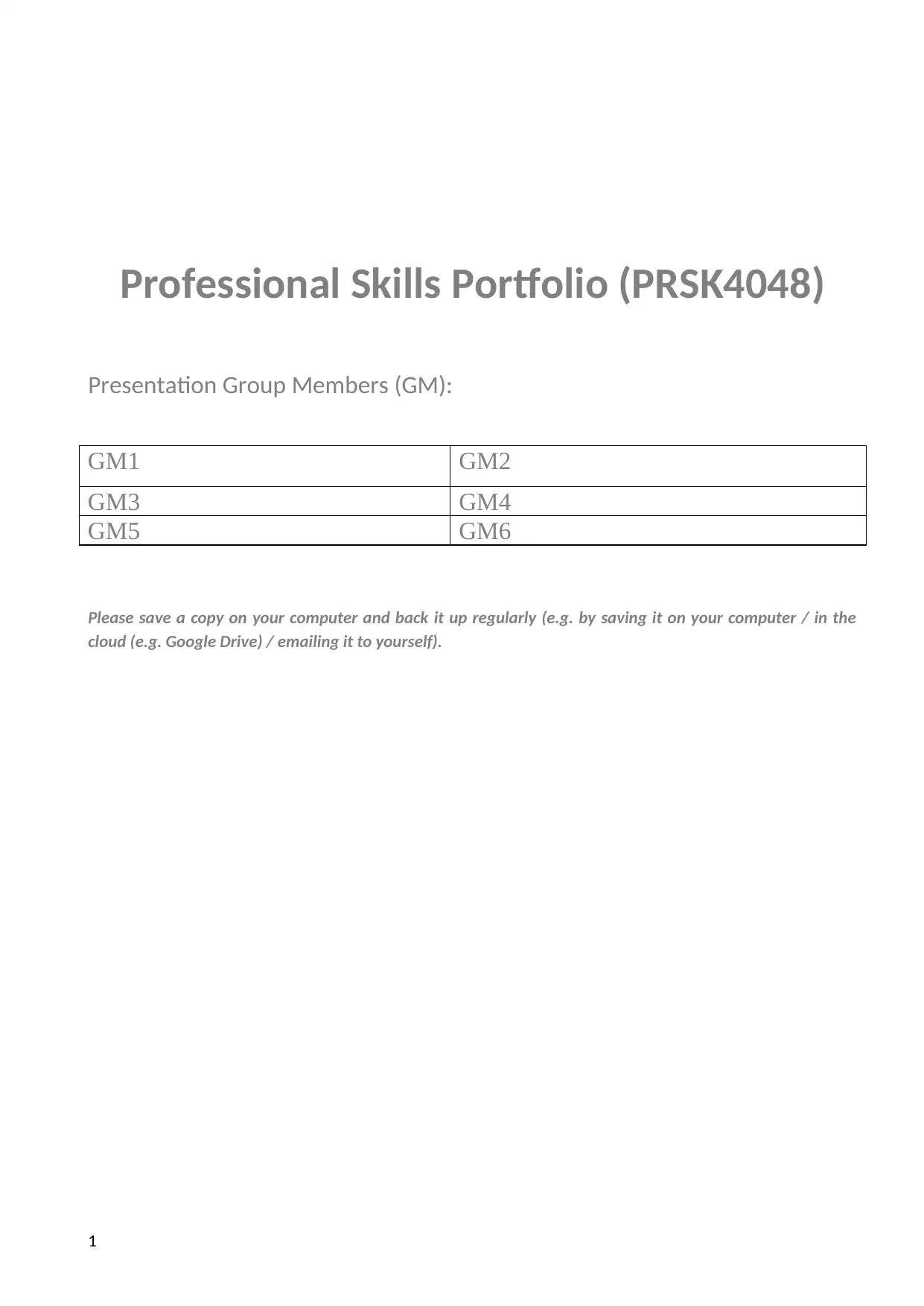
Professional Skills Portfolio (PRSK4048)
Presentation Group Members (GM):
GM1 GM2
GM3 GM4
GM5 GM6
Please save a copy on your computer and back it up regularly (e.g. by saving it on your computer / in the
cloud (e.g. Google Drive) / emailing it to yourself).
1
Presentation Group Members (GM):
GM1 GM2
GM3 GM4
GM5 GM6
Please save a copy on your computer and back it up regularly (e.g. by saving it on your computer / in the
cloud (e.g. Google Drive) / emailing it to yourself).
1
Paraphrase This Document
Need a fresh take? Get an instant paraphrase of this document with our AI Paraphraser
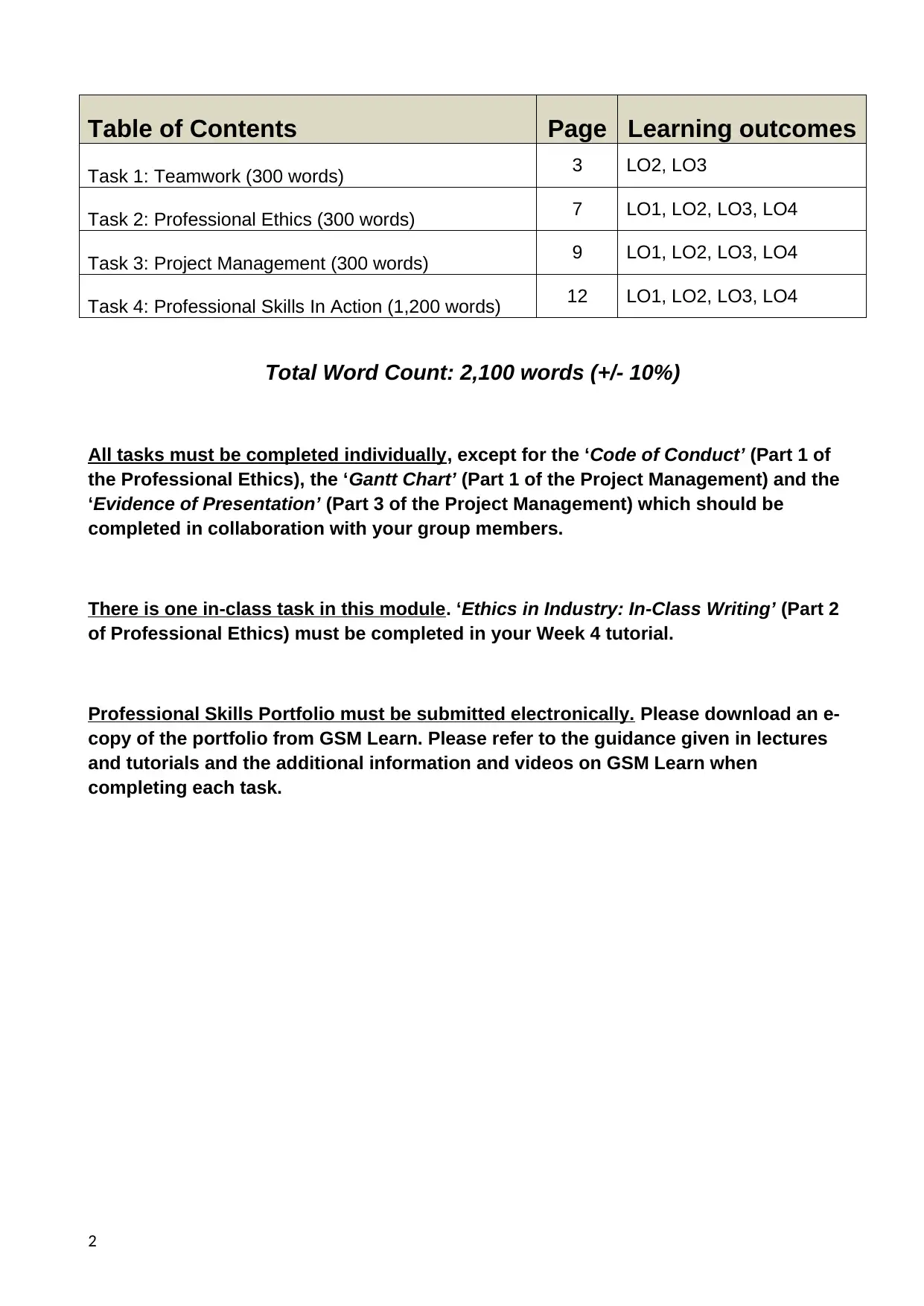
Table of Contents Page Learning outcomes
Task 1: Teamwork (300 words) 3 LO2, LO3
Task 2: Professional Ethics (300 words) 7 LO1, LO2, LO3, LO4
Task 3: Project Management (300 words) 9 LO1, LO2, LO3, LO4
Task 4: Professional Skills In Action (1,200 words) 12 LO1, LO2, LO3, LO4
Total Word Count: 2,100 words (+/- 10%)
All tasks must be completed individually, except for the ‘Code of Conduct’ (Part 1 of
the Professional Ethics), the ‘Gantt Chart’ (Part 1 of the Project Management) and the
‘Evidence of Presentation’ (Part 3 of the Project Management) which should be
completed in collaboration with your group members.
There is one in-class task in this module. ‘Ethics in Industry: In-Class Writing’ (Part 2
of Professional Ethics) must be completed in your Week 4 tutorial.
Professional Skills Portfolio must be submitted electronically. Please download an e-
copy of the portfolio from GSM Learn. Please refer to the guidance given in lectures
and tutorials and the additional information and videos on GSM Learn when
completing each task.
2
Task 1: Teamwork (300 words) 3 LO2, LO3
Task 2: Professional Ethics (300 words) 7 LO1, LO2, LO3, LO4
Task 3: Project Management (300 words) 9 LO1, LO2, LO3, LO4
Task 4: Professional Skills In Action (1,200 words) 12 LO1, LO2, LO3, LO4
Total Word Count: 2,100 words (+/- 10%)
All tasks must be completed individually, except for the ‘Code of Conduct’ (Part 1 of
the Professional Ethics), the ‘Gantt Chart’ (Part 1 of the Project Management) and the
‘Evidence of Presentation’ (Part 3 of the Project Management) which should be
completed in collaboration with your group members.
There is one in-class task in this module. ‘Ethics in Industry: In-Class Writing’ (Part 2
of Professional Ethics) must be completed in your Week 4 tutorial.
Professional Skills Portfolio must be submitted electronically. Please download an e-
copy of the portfolio from GSM Learn. Please refer to the guidance given in lectures
and tutorials and the additional information and videos on GSM Learn when
completing each task.
2
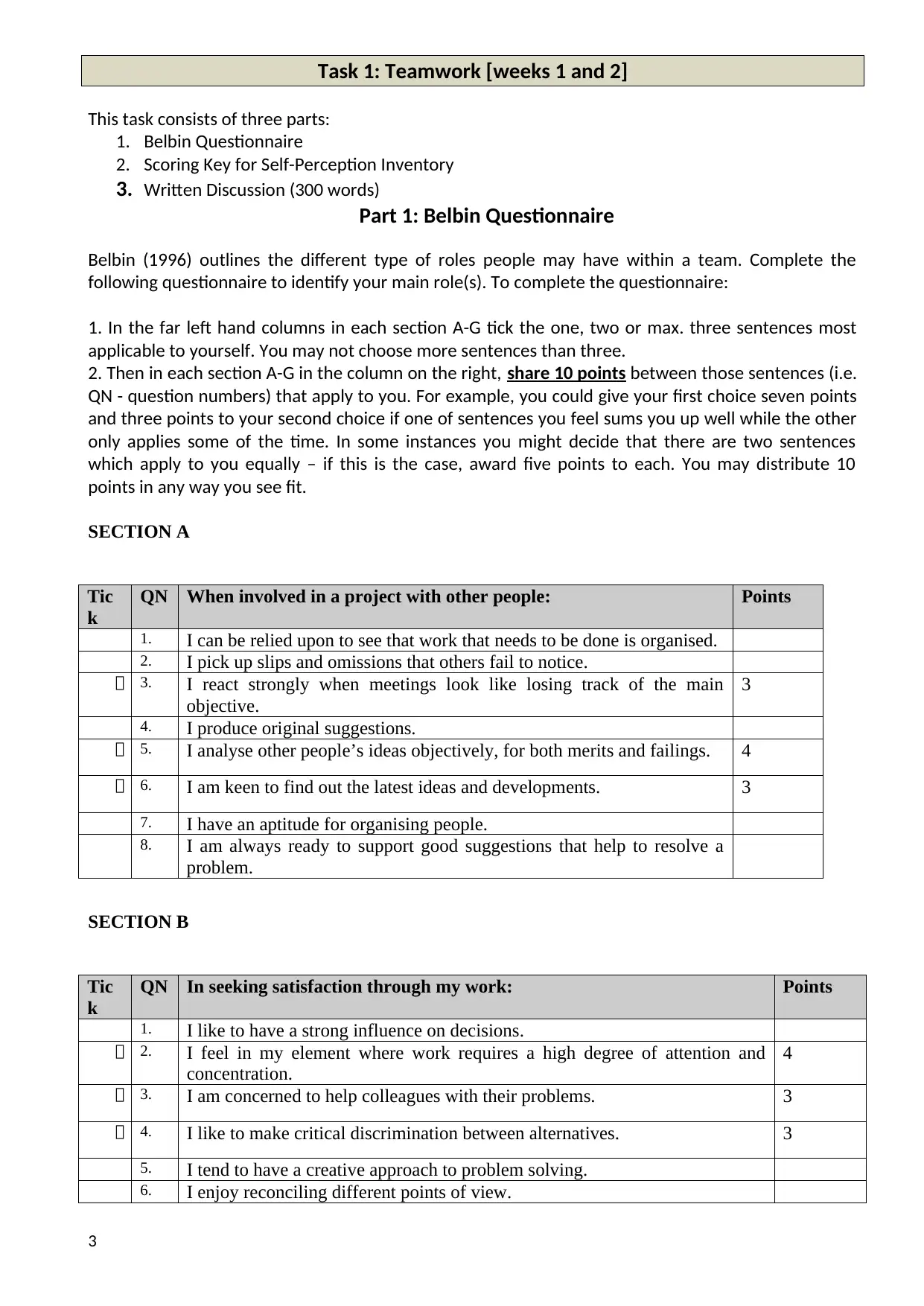
Task 1: Teamwork [weeks 1 and 2]
This task consists of three parts:
1. Belbin Questionnaire
2. Scoring Key for Self-Perception Inventory
3. Written Discussion (300 words)
Part 1: Belbin Questionnaire
Belbin (1996) outlines the different type of roles people may have within a team. Complete the
following questionnaire to identify your main role(s). To complete the questionnaire:
1. In the far left hand columns in each section A-G tick the one, two or max. three sentences most
applicable to yourself. You may not choose more sentences than three.
2. Then in each section A-G in the column on the right, share 10 points between those sentences (i.e.
QN - question numbers) that apply to you. For example, you could give your first choice seven points
and three points to your second choice if one of sentences you feel sums you up well while the other
only applies some of the time. In some instances you might decide that there are two sentences
which apply to you equally – if this is the case, award five points to each. You may distribute 10
points in any way you see fit.
SECTION A
Tic
k
QN When involved in a project with other people: Points
1. I can be relied upon to see that work that needs to be done is organised.
2. I pick up slips and omissions that others fail to notice.
3. I react strongly when meetings look like losing track of the main
objective.
3
4. I produce original suggestions.
5. I analyse other people’s ideas objectively, for both merits and failings. 4
6. I am keen to find out the latest ideas and developments. 3
7. I have an aptitude for organising people.
8. I am always ready to support good suggestions that help to resolve a
problem.
SECTION B
Tic
k
QN In seeking satisfaction through my work: Points
1. I like to have a strong influence on decisions.
2. I feel in my element where work requires a high degree of attention and
concentration.
4
3. I am concerned to help colleagues with their problems. 3
4. I like to make critical discrimination between alternatives. 3
5. I tend to have a creative approach to problem solving.
6. I enjoy reconciling different points of view.
3
This task consists of three parts:
1. Belbin Questionnaire
2. Scoring Key for Self-Perception Inventory
3. Written Discussion (300 words)
Part 1: Belbin Questionnaire
Belbin (1996) outlines the different type of roles people may have within a team. Complete the
following questionnaire to identify your main role(s). To complete the questionnaire:
1. In the far left hand columns in each section A-G tick the one, two or max. three sentences most
applicable to yourself. You may not choose more sentences than three.
2. Then in each section A-G in the column on the right, share 10 points between those sentences (i.e.
QN - question numbers) that apply to you. For example, you could give your first choice seven points
and three points to your second choice if one of sentences you feel sums you up well while the other
only applies some of the time. In some instances you might decide that there are two sentences
which apply to you equally – if this is the case, award five points to each. You may distribute 10
points in any way you see fit.
SECTION A
Tic
k
QN When involved in a project with other people: Points
1. I can be relied upon to see that work that needs to be done is organised.
2. I pick up slips and omissions that others fail to notice.
3. I react strongly when meetings look like losing track of the main
objective.
3
4. I produce original suggestions.
5. I analyse other people’s ideas objectively, for both merits and failings. 4
6. I am keen to find out the latest ideas and developments. 3
7. I have an aptitude for organising people.
8. I am always ready to support good suggestions that help to resolve a
problem.
SECTION B
Tic
k
QN In seeking satisfaction through my work: Points
1. I like to have a strong influence on decisions.
2. I feel in my element where work requires a high degree of attention and
concentration.
4
3. I am concerned to help colleagues with their problems. 3
4. I like to make critical discrimination between alternatives. 3
5. I tend to have a creative approach to problem solving.
6. I enjoy reconciling different points of view.
3
⊘ This is a preview!⊘
Do you want full access?
Subscribe today to unlock all pages.

Trusted by 1+ million students worldwide
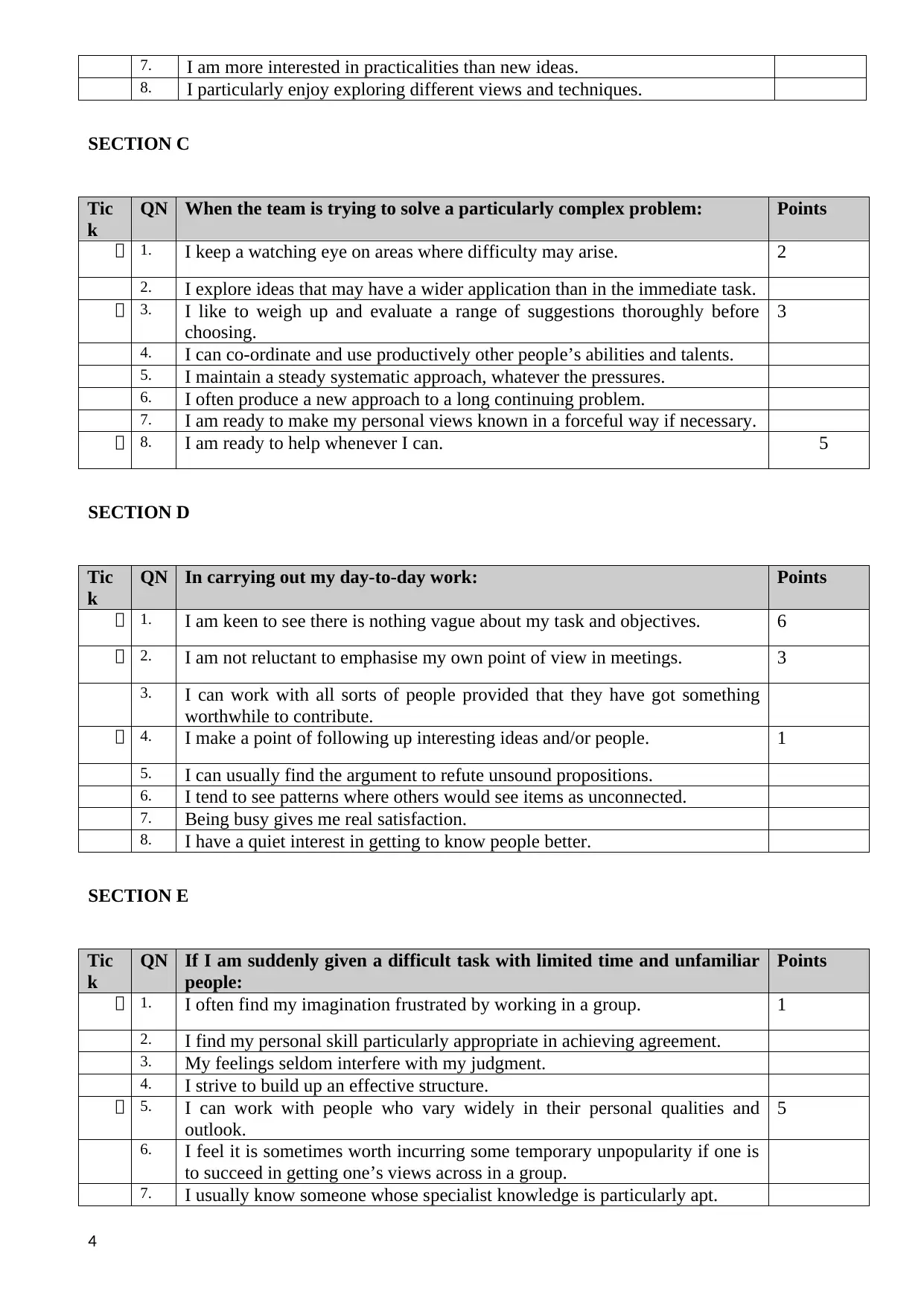
7. I am more interested in practicalities than new ideas.
8. I particularly enjoy exploring different views and techniques.
SECTION C
Tic
k
QN When the team is trying to solve a particularly complex problem: Points
1. I keep a watching eye on areas where difficulty may arise. 2
2. I explore ideas that may have a wider application than in the immediate task.
3. I like to weigh up and evaluate a range of suggestions thoroughly before
choosing.
3
4. I can co-ordinate and use productively other people’s abilities and talents.
5. I maintain a steady systematic approach, whatever the pressures.
6. I often produce a new approach to a long continuing problem.
7. I am ready to make my personal views known in a forceful way if necessary.
8. I am ready to help whenever I can. 5
SECTION D
Tic
k
QN In carrying out my day-to-day work: Points
1. I am keen to see there is nothing vague about my task and objectives. 6
2. I am not reluctant to emphasise my own point of view in meetings. 3
3. I can work with all sorts of people provided that they have got something
worthwhile to contribute.
4. I make a point of following up interesting ideas and/or people. 1
5. I can usually find the argument to refute unsound propositions.
6. I tend to see patterns where others would see items as unconnected.
7. Being busy gives me real satisfaction.
8. I have a quiet interest in getting to know people better.
SECTION E
Tic
k
QN If I am suddenly given a difficult task with limited time and unfamiliar
people:
Points
1. I often find my imagination frustrated by working in a group. 1
2. I find my personal skill particularly appropriate in achieving agreement.
3. My feelings seldom interfere with my judgment.
4. I strive to build up an effective structure.
5. I can work with people who vary widely in their personal qualities and
outlook.
5
6. I feel it is sometimes worth incurring some temporary unpopularity if one is
to succeed in getting one’s views across in a group.
7. I usually know someone whose specialist knowledge is particularly apt.
4
8. I particularly enjoy exploring different views and techniques.
SECTION C
Tic
k
QN When the team is trying to solve a particularly complex problem: Points
1. I keep a watching eye on areas where difficulty may arise. 2
2. I explore ideas that may have a wider application than in the immediate task.
3. I like to weigh up and evaluate a range of suggestions thoroughly before
choosing.
3
4. I can co-ordinate and use productively other people’s abilities and talents.
5. I maintain a steady systematic approach, whatever the pressures.
6. I often produce a new approach to a long continuing problem.
7. I am ready to make my personal views known in a forceful way if necessary.
8. I am ready to help whenever I can. 5
SECTION D
Tic
k
QN In carrying out my day-to-day work: Points
1. I am keen to see there is nothing vague about my task and objectives. 6
2. I am not reluctant to emphasise my own point of view in meetings. 3
3. I can work with all sorts of people provided that they have got something
worthwhile to contribute.
4. I make a point of following up interesting ideas and/or people. 1
5. I can usually find the argument to refute unsound propositions.
6. I tend to see patterns where others would see items as unconnected.
7. Being busy gives me real satisfaction.
8. I have a quiet interest in getting to know people better.
SECTION E
Tic
k
QN If I am suddenly given a difficult task with limited time and unfamiliar
people:
Points
1. I often find my imagination frustrated by working in a group. 1
2. I find my personal skill particularly appropriate in achieving agreement.
3. My feelings seldom interfere with my judgment.
4. I strive to build up an effective structure.
5. I can work with people who vary widely in their personal qualities and
outlook.
5
6. I feel it is sometimes worth incurring some temporary unpopularity if one is
to succeed in getting one’s views across in a group.
7. I usually know someone whose specialist knowledge is particularly apt.
4
Paraphrase This Document
Need a fresh take? Get an instant paraphrase of this document with our AI Paraphraser
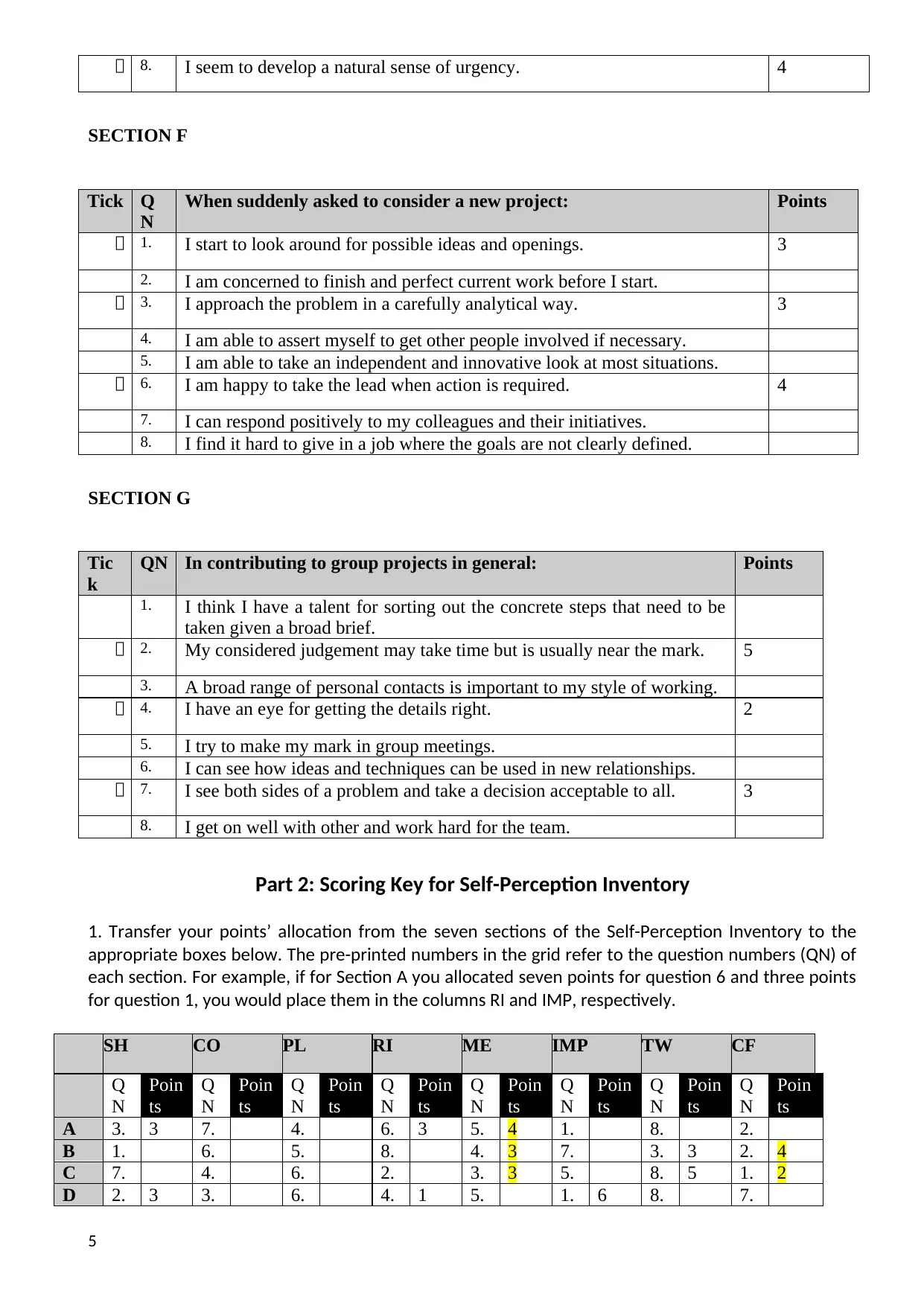
8. I seem to develop a natural sense of urgency. 4
SECTION F
Tick Q
N
When suddenly asked to consider a new project: Points
1. I start to look around for possible ideas and openings. 3
2. I am concerned to finish and perfect current work before I start.
3. I approach the problem in a carefully analytical way. 3
4. I am able to assert myself to get other people involved if necessary.
5. I am able to take an independent and innovative look at most situations.
6. I am happy to take the lead when action is required. 4
7. I can respond positively to my colleagues and their initiatives.
8. I find it hard to give in a job where the goals are not clearly defined.
SECTION G
Tic
k
QN In contributing to group projects in general: Points
1. I think I have a talent for sorting out the concrete steps that need to be
taken given a broad brief.
2. My considered judgement may take time but is usually near the mark. 5
3. A broad range of personal contacts is important to my style of working.
4. I have an eye for getting the details right. 2
5. I try to make my mark in group meetings.
6. I can see how ideas and techniques can be used in new relationships.
7. I see both sides of a problem and take a decision acceptable to all. 3
8. I get on well with other and work hard for the team.
Part 2: Scoring Key for Self-Perception Inventory
1. Transfer your points’ allocation from the seven sections of the Self-Perception Inventory to the
appropriate boxes below. The pre-printed numbers in the grid refer to the question numbers (QN) of
each section. For example, if for Section A you allocated seven points for question 6 and three points
for question 1, you would place them in the columns RI and IMP, respectively.
SH CO PL RI ME IMP TW CF
Q
N
Poin
ts
Q
N
Poin
ts
Q
N
Poin
ts
Q
N
Poin
ts
Q
N
Poin
ts
Q
N
Poin
ts
Q
N
Poin
ts
Q
N
Poin
ts
A 3. 3 7. 4. 6. 3 5. 4 1. 8. 2.
B 1. 6. 5. 8. 4. 3 7. 3. 3 2. 4
C 7. 4. 6. 2. 3. 3 5. 8. 5 1. 2
D 2. 3 3. 6. 4. 1 5. 1. 6 8. 7.
5
SECTION F
Tick Q
N
When suddenly asked to consider a new project: Points
1. I start to look around for possible ideas and openings. 3
2. I am concerned to finish and perfect current work before I start.
3. I approach the problem in a carefully analytical way. 3
4. I am able to assert myself to get other people involved if necessary.
5. I am able to take an independent and innovative look at most situations.
6. I am happy to take the lead when action is required. 4
7. I can respond positively to my colleagues and their initiatives.
8. I find it hard to give in a job where the goals are not clearly defined.
SECTION G
Tic
k
QN In contributing to group projects in general: Points
1. I think I have a talent for sorting out the concrete steps that need to be
taken given a broad brief.
2. My considered judgement may take time but is usually near the mark. 5
3. A broad range of personal contacts is important to my style of working.
4. I have an eye for getting the details right. 2
5. I try to make my mark in group meetings.
6. I can see how ideas and techniques can be used in new relationships.
7. I see both sides of a problem and take a decision acceptable to all. 3
8. I get on well with other and work hard for the team.
Part 2: Scoring Key for Self-Perception Inventory
1. Transfer your points’ allocation from the seven sections of the Self-Perception Inventory to the
appropriate boxes below. The pre-printed numbers in the grid refer to the question numbers (QN) of
each section. For example, if for Section A you allocated seven points for question 6 and three points
for question 1, you would place them in the columns RI and IMP, respectively.
SH CO PL RI ME IMP TW CF
Q
N
Poin
ts
Q
N
Poin
ts
Q
N
Poin
ts
Q
N
Poin
ts
Q
N
Poin
ts
Q
N
Poin
ts
Q
N
Poin
ts
Q
N
Poin
ts
A 3. 3 7. 4. 6. 3 5. 4 1. 8. 2.
B 1. 6. 5. 8. 4. 3 7. 3. 3 2. 4
C 7. 4. 6. 2. 3. 3 5. 8. 5 1. 2
D 2. 3 3. 6. 4. 1 5. 1. 6 8. 7.
5
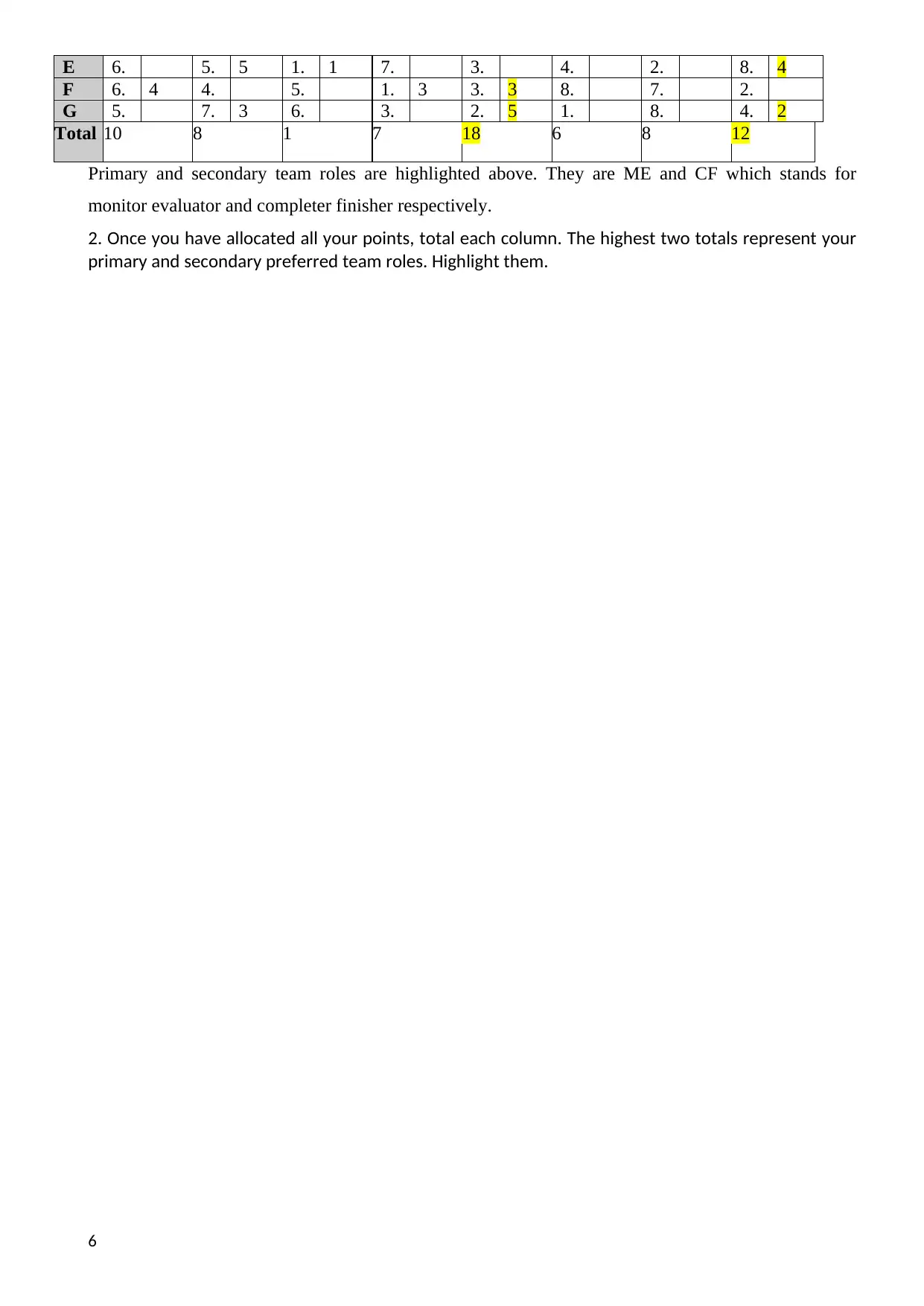
E 6. 5. 5 1. 1 7. 3. 4. 2. 8. 4
F 6. 4 4. 5. 1. 3 3. 3 8. 7. 2.
G 5. 7. 3 6. 3. 2. 5 1. 8. 4. 2
Total 10 8 1 7 18 6 8 12
Primary and secondary team roles are highlighted above. They are ME and CF which stands for
monitor evaluator and completer finisher respectively.
2. Once you have allocated all your points, total each column. The highest two totals represent your
primary and secondary preferred team roles. Highlight them.
6
F 6. 4 4. 5. 1. 3 3. 3 8. 7. 2.
G 5. 7. 3 6. 3. 2. 5 1. 8. 4. 2
Total 10 8 1 7 18 6 8 12
Primary and secondary team roles are highlighted above. They are ME and CF which stands for
monitor evaluator and completer finisher respectively.
2. Once you have allocated all your points, total each column. The highest two totals represent your
primary and secondary preferred team roles. Highlight them.
6
⊘ This is a preview!⊘
Do you want full access?
Subscribe today to unlock all pages.

Trusted by 1+ million students worldwide
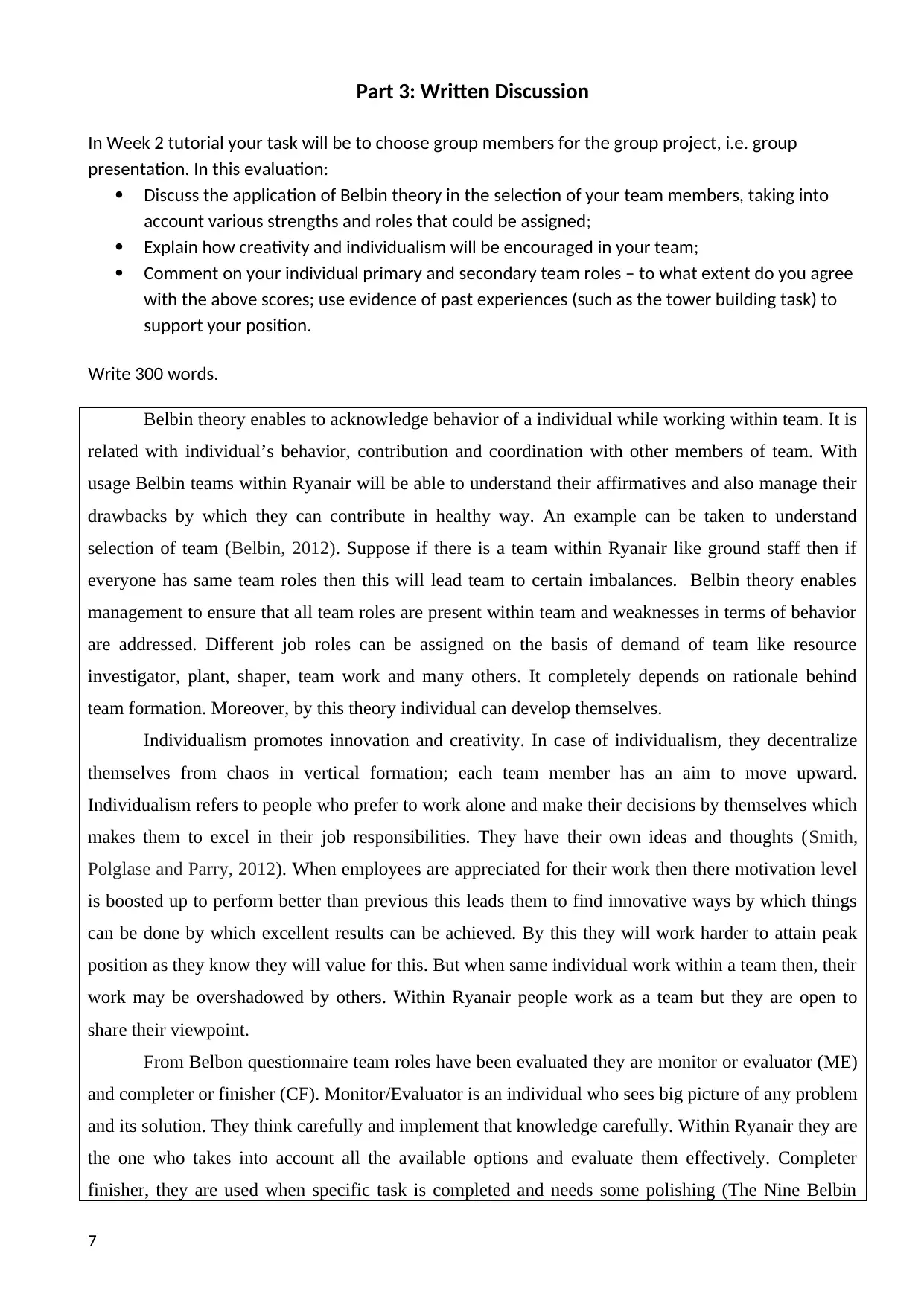
Part 3: Written Discussion
In Week 2 tutorial your task will be to choose group members for the group project, i.e. group
presentation. In this evaluation:
Discuss the application of Belbin theory in the selection of your team members, taking into
account various strengths and roles that could be assigned;
Explain how creativity and individualism will be encouraged in your team;
Comment on your individual primary and secondary team roles – to what extent do you agree
with the above scores; use evidence of past experiences (such as the tower building task) to
support your position.
Write 300 words.
Belbin theory enables to acknowledge behavior of a individual while working within team. It is
related with individual’s behavior, contribution and coordination with other members of team. With
usage Belbin teams within Ryanair will be able to understand their affirmatives and also manage their
drawbacks by which they can contribute in healthy way. An example can be taken to understand
selection of team (Belbin, 2012). Suppose if there is a team within Ryanair like ground staff then if
everyone has same team roles then this will lead team to certain imbalances. Belbin theory enables
management to ensure that all team roles are present within team and weaknesses in terms of behavior
are addressed. Different job roles can be assigned on the basis of demand of team like resource
investigator, plant, shaper, team work and many others. It completely depends on rationale behind
team formation. Moreover, by this theory individual can develop themselves.
Individualism promotes innovation and creativity. In case of individualism, they decentralize
themselves from chaos in vertical formation; each team member has an aim to move upward.
Individualism refers to people who prefer to work alone and make their decisions by themselves which
makes them to excel in their job responsibilities. They have their own ideas and thoughts (Smith,
Polglase and Parry, 2012). When employees are appreciated for their work then there motivation level
is boosted up to perform better than previous this leads them to find innovative ways by which things
can be done by which excellent results can be achieved. By this they will work harder to attain peak
position as they know they will value for this. But when same individual work within a team then, their
work may be overshadowed by others. Within Ryanair people work as a team but they are open to
share their viewpoint.
From Belbon questionnaire team roles have been evaluated they are monitor or evaluator (ME)
and completer or finisher (CF). Monitor/Evaluator is an individual who sees big picture of any problem
and its solution. They think carefully and implement that knowledge carefully. Within Ryanair they are
the one who takes into account all the available options and evaluate them effectively. Completer
finisher, they are used when specific task is completed and needs some polishing (The Nine Belbin
7
In Week 2 tutorial your task will be to choose group members for the group project, i.e. group
presentation. In this evaluation:
Discuss the application of Belbin theory in the selection of your team members, taking into
account various strengths and roles that could be assigned;
Explain how creativity and individualism will be encouraged in your team;
Comment on your individual primary and secondary team roles – to what extent do you agree
with the above scores; use evidence of past experiences (such as the tower building task) to
support your position.
Write 300 words.
Belbin theory enables to acknowledge behavior of a individual while working within team. It is
related with individual’s behavior, contribution and coordination with other members of team. With
usage Belbin teams within Ryanair will be able to understand their affirmatives and also manage their
drawbacks by which they can contribute in healthy way. An example can be taken to understand
selection of team (Belbin, 2012). Suppose if there is a team within Ryanair like ground staff then if
everyone has same team roles then this will lead team to certain imbalances. Belbin theory enables
management to ensure that all team roles are present within team and weaknesses in terms of behavior
are addressed. Different job roles can be assigned on the basis of demand of team like resource
investigator, plant, shaper, team work and many others. It completely depends on rationale behind
team formation. Moreover, by this theory individual can develop themselves.
Individualism promotes innovation and creativity. In case of individualism, they decentralize
themselves from chaos in vertical formation; each team member has an aim to move upward.
Individualism refers to people who prefer to work alone and make their decisions by themselves which
makes them to excel in their job responsibilities. They have their own ideas and thoughts (Smith,
Polglase and Parry, 2012). When employees are appreciated for their work then there motivation level
is boosted up to perform better than previous this leads them to find innovative ways by which things
can be done by which excellent results can be achieved. By this they will work harder to attain peak
position as they know they will value for this. But when same individual work within a team then, their
work may be overshadowed by others. Within Ryanair people work as a team but they are open to
share their viewpoint.
From Belbon questionnaire team roles have been evaluated they are monitor or evaluator (ME)
and completer or finisher (CF). Monitor/Evaluator is an individual who sees big picture of any problem
and its solution. They think carefully and implement that knowledge carefully. Within Ryanair they are
the one who takes into account all the available options and evaluate them effectively. Completer
finisher, they are used when specific task is completed and needs some polishing (The Nine Belbin
7
Paraphrase This Document
Need a fresh take? Get an instant paraphrase of this document with our AI Paraphraser
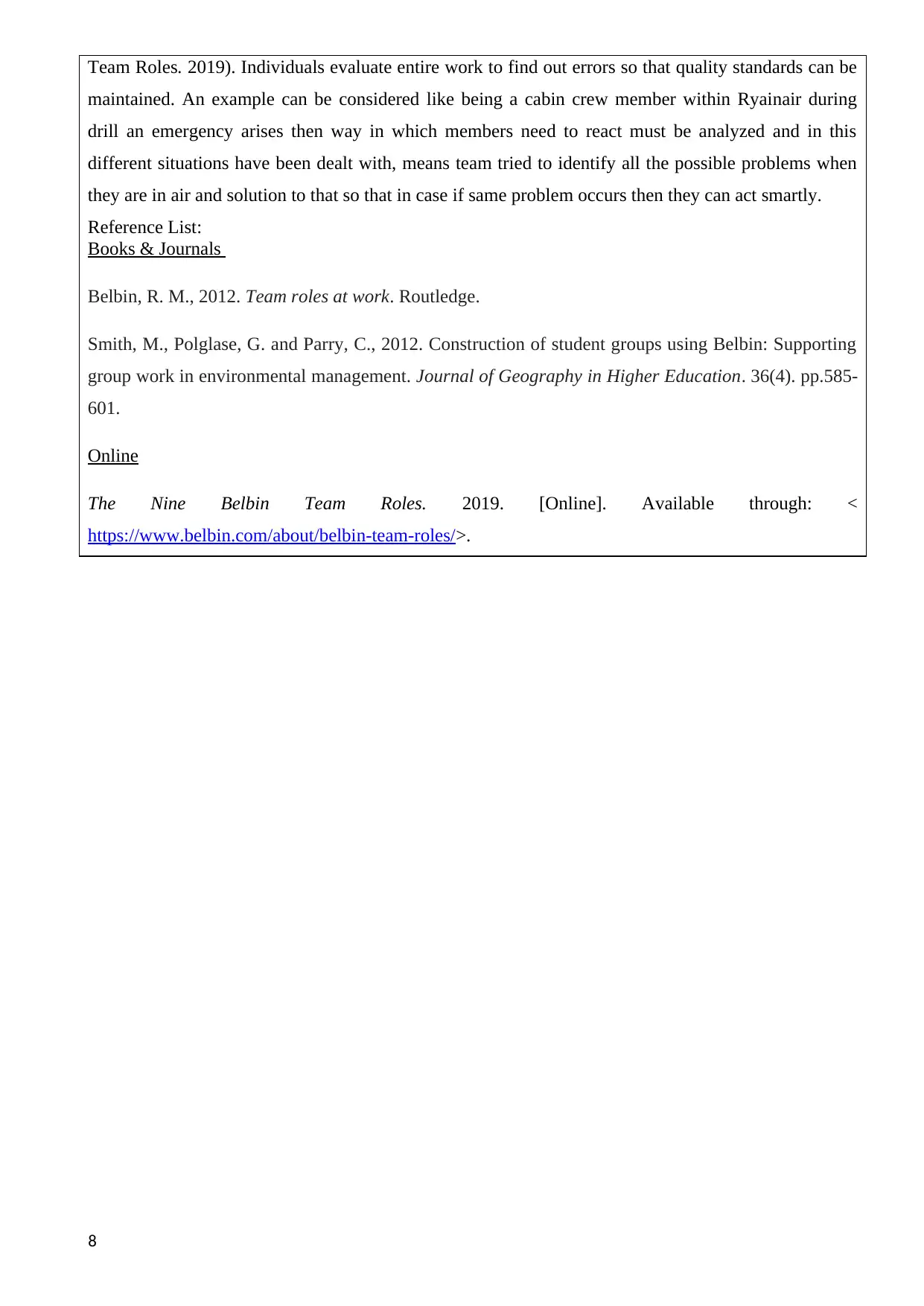
Team Roles. 2019). Individuals evaluate entire work to find out errors so that quality standards can be
maintained. An example can be considered like being a cabin crew member within Ryainair during
drill an emergency arises then way in which members need to react must be analyzed and in this
different situations have been dealt with, means team tried to identify all the possible problems when
they are in air and solution to that so that in case if same problem occurs then they can act smartly.
Reference List:
Books & Journals
Belbin, R. M., 2012. Team roles at work. Routledge.
Smith, M., Polglase, G. and Parry, C., 2012. Construction of student groups using Belbin: Supporting
group work in environmental management. Journal of Geography in Higher Education. 36(4). pp.585-
601.
Online
The Nine Belbin Team Roles. 2019. [Online]. Available through: <
https://www.belbin.com/about/belbin-team-roles/>.
8
maintained. An example can be considered like being a cabin crew member within Ryainair during
drill an emergency arises then way in which members need to react must be analyzed and in this
different situations have been dealt with, means team tried to identify all the possible problems when
they are in air and solution to that so that in case if same problem occurs then they can act smartly.
Reference List:
Books & Journals
Belbin, R. M., 2012. Team roles at work. Routledge.
Smith, M., Polglase, G. and Parry, C., 2012. Construction of student groups using Belbin: Supporting
group work in environmental management. Journal of Geography in Higher Education. 36(4). pp.585-
601.
Online
The Nine Belbin Team Roles. 2019. [Online]. Available through: <
https://www.belbin.com/about/belbin-team-roles/>.
8
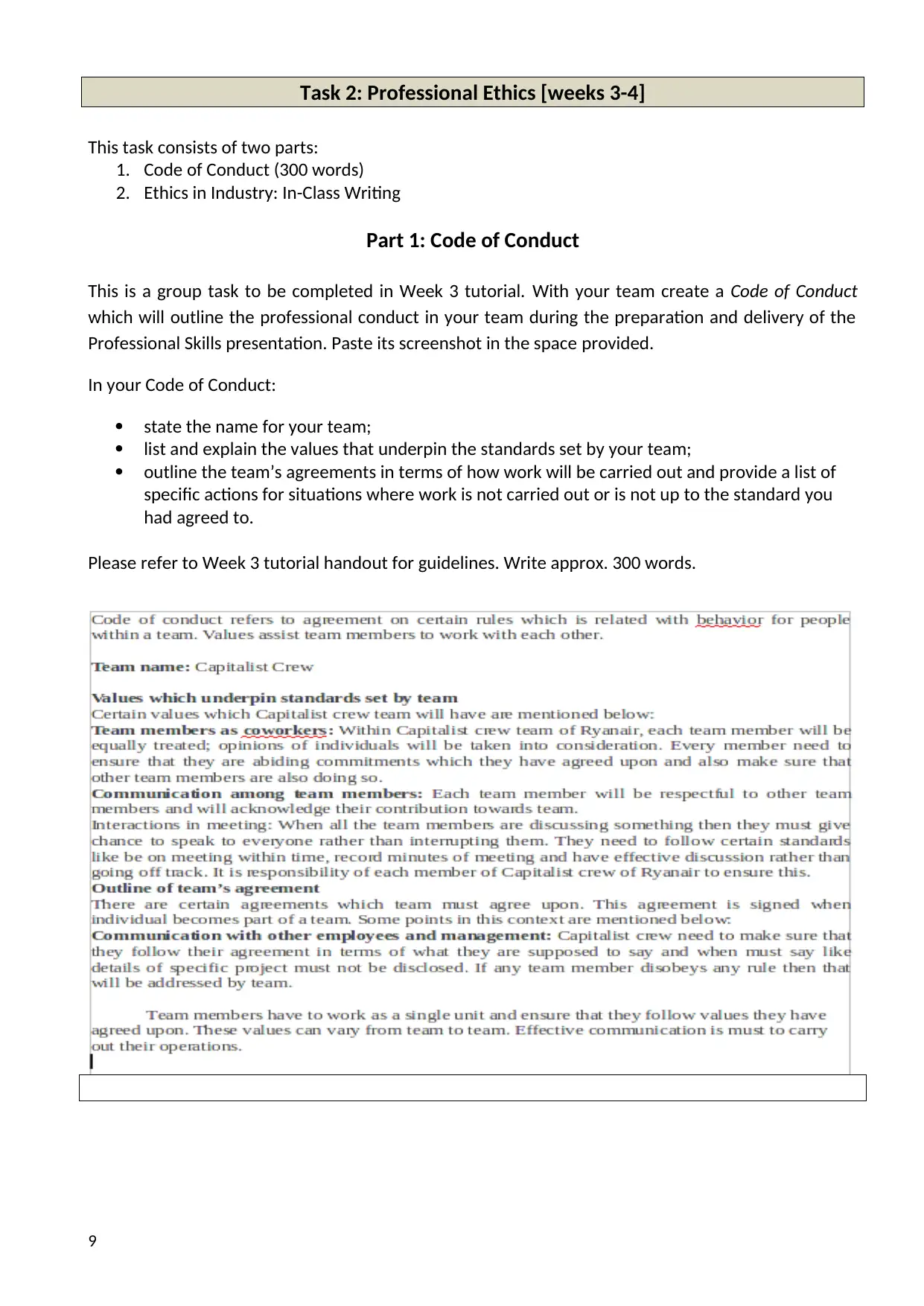
Task 2: Professional Ethics [weeks 3-4]
This task consists of two parts:
1. Code of Conduct (300 words)
2. Ethics in Industry: In-Class Writing
Part 1: Code of Conduct
This is a group task to be completed in Week 3 tutorial. With your team create a Code of Conduct
which will outline the professional conduct in your team during the preparation and delivery of the
Professional Skills presentation. Paste its screenshot in the space provided.
In your Code of Conduct:
state the name for your team;
list and explain the values that underpin the standards set by your team;
outline the team’s agreements in terms of how work will be carried out and provide a list of
specific actions for situations where work is not carried out or is not up to the standard you
had agreed to.
Please refer to Week 3 tutorial handout for guidelines. Write approx. 300 words.
9
This task consists of two parts:
1. Code of Conduct (300 words)
2. Ethics in Industry: In-Class Writing
Part 1: Code of Conduct
This is a group task to be completed in Week 3 tutorial. With your team create a Code of Conduct
which will outline the professional conduct in your team during the preparation and delivery of the
Professional Skills presentation. Paste its screenshot in the space provided.
In your Code of Conduct:
state the name for your team;
list and explain the values that underpin the standards set by your team;
outline the team’s agreements in terms of how work will be carried out and provide a list of
specific actions for situations where work is not carried out or is not up to the standard you
had agreed to.
Please refer to Week 3 tutorial handout for guidelines. Write approx. 300 words.
9
⊘ This is a preview!⊘
Do you want full access?
Subscribe today to unlock all pages.

Trusted by 1+ million students worldwide
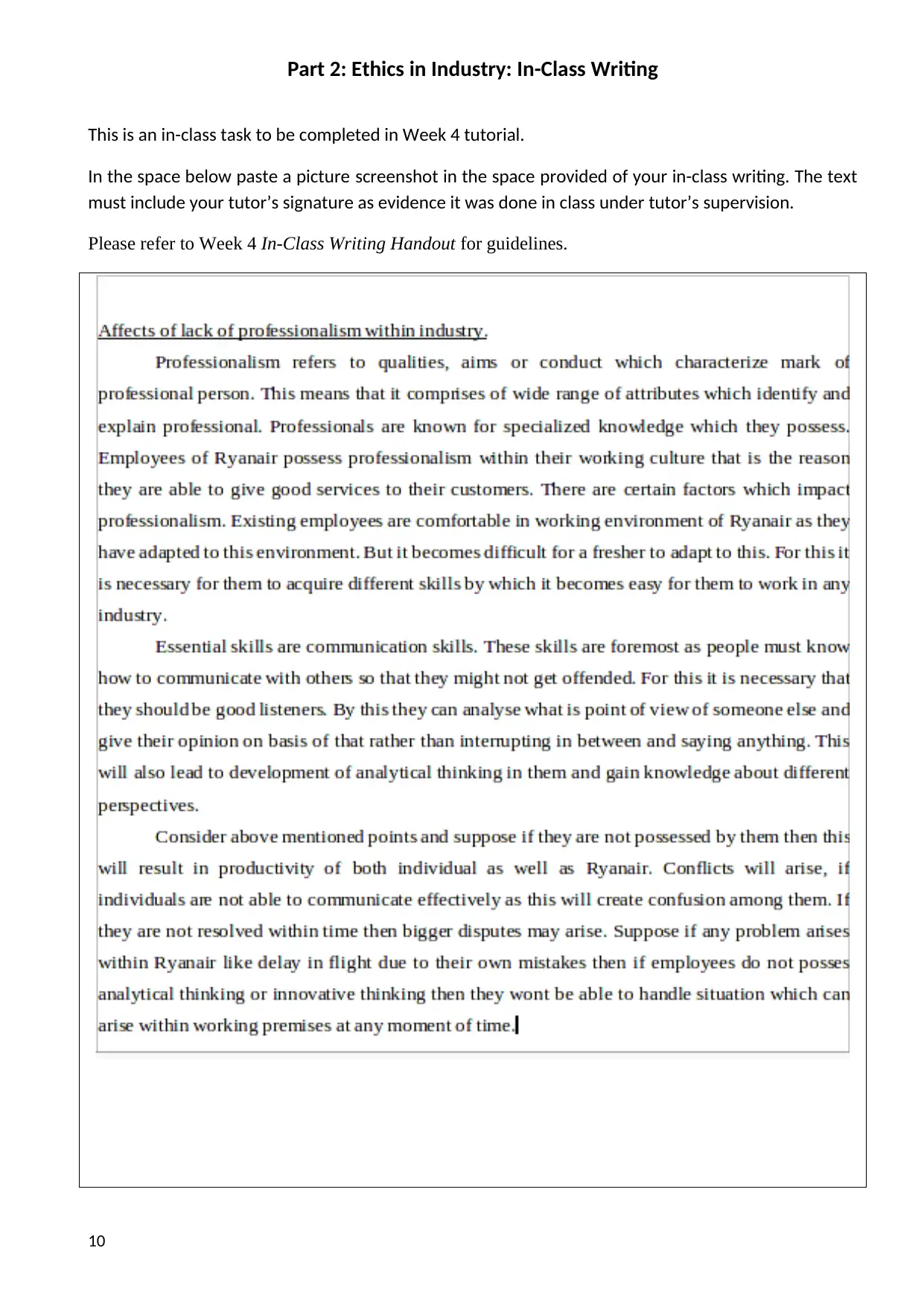
Part 2: Ethics in Industry: In-Class Writing
This is an in-class task to be completed in Week 4 tutorial.
In the space below paste a picture screenshot in the space provided of your in-class writing. The text
must include your tutor’s signature as evidence it was done in class under tutor’s supervision.
Please refer to Week 4 In-Class Writing Handout for guidelines.
10
This is an in-class task to be completed in Week 4 tutorial.
In the space below paste a picture screenshot in the space provided of your in-class writing. The text
must include your tutor’s signature as evidence it was done in class under tutor’s supervision.
Please refer to Week 4 In-Class Writing Handout for guidelines.
10
Paraphrase This Document
Need a fresh take? Get an instant paraphrase of this document with our AI Paraphraser

11
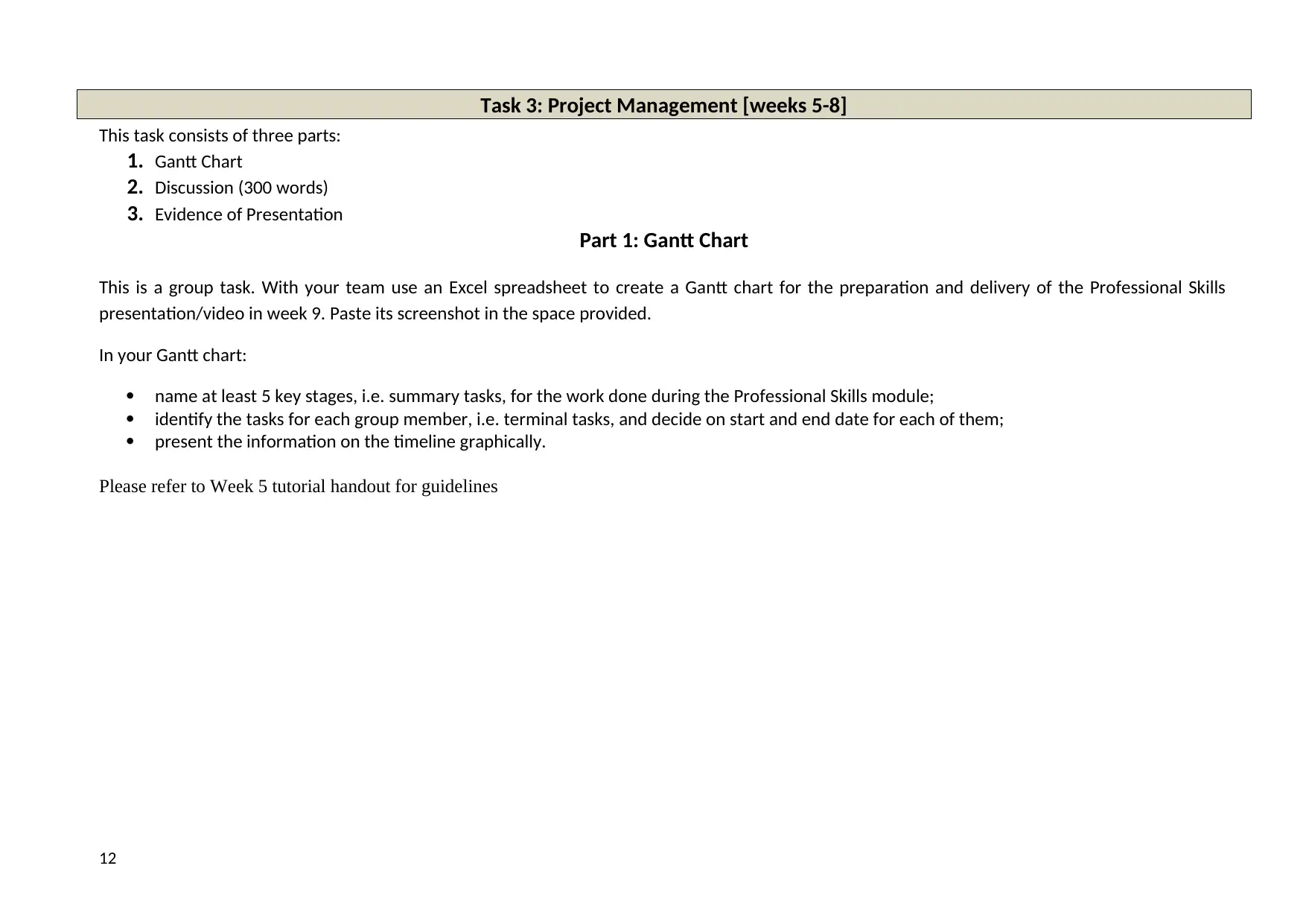
Task 3: Project Management [weeks 5-8]
This task consists of three parts:
1. Gantt Chart
2. Discussion (300 words)
3. Evidence of Presentation
Part 1: Gantt Chart
This is a group task. With your team use an Excel spreadsheet to create a Gantt chart for the preparation and delivery of the Professional Skills
presentation/video in week 9. Paste its screenshot in the space provided.
In your Gantt chart:
name at least 5 key stages, i.e. summary tasks, for the work done during the Professional Skills module;
identify the tasks for each group member, i.e. terminal tasks, and decide on start and end date for each of them;
present the information on the timeline graphically.
Please refer to Week 5 tutorial handout for guidelines
12
This task consists of three parts:
1. Gantt Chart
2. Discussion (300 words)
3. Evidence of Presentation
Part 1: Gantt Chart
This is a group task. With your team use an Excel spreadsheet to create a Gantt chart for the preparation and delivery of the Professional Skills
presentation/video in week 9. Paste its screenshot in the space provided.
In your Gantt chart:
name at least 5 key stages, i.e. summary tasks, for the work done during the Professional Skills module;
identify the tasks for each group member, i.e. terminal tasks, and decide on start and end date for each of them;
present the information on the timeline graphically.
Please refer to Week 5 tutorial handout for guidelines
12
⊘ This is a preview!⊘
Do you want full access?
Subscribe today to unlock all pages.

Trusted by 1+ million students worldwide
1 out of 26
Related Documents
Your All-in-One AI-Powered Toolkit for Academic Success.
+13062052269
info@desklib.com
Available 24*7 on WhatsApp / Email
![[object Object]](/_next/static/media/star-bottom.7253800d.svg)
Unlock your academic potential
Copyright © 2020–2025 A2Z Services. All Rights Reserved. Developed and managed by ZUCOL.





